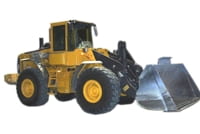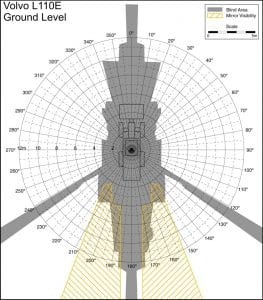 Operator blind spots are a serious liability risk in work zones and workers are paying with their lives. Highway work zones, under the best of circumstances, can be chaotic and dangerous. In fact, about 750 fatalities occur each year in U.S. work zones and some 120 workers are killed each year, half of them from runovers and backovers (often by dump trucks).
Operator blind spots are a serious liability risk in work zones and workers are paying with their lives. Highway work zones, under the best of circumstances, can be chaotic and dangerous. In fact, about 750 fatalities occur each year in U.S. work zones and some 120 workers are killed each year, half of them from runovers and backovers (often by dump trucks).
The Bureau of Labor Statistics reports fatal injuries to workers at road construction sites and 1,435 workers lost their lives at such sites between 2003 and 2014. That means fatal work-related injuries at road construction sites averaged nearly 120 per year during that period. The primary causes of worker fatalities in recent years were:
- Runovers/backovers (often by dump trucks): 48%
- Collision Between Vehicles/Mobile Equipment: 14%
- Caught in Between/Struck by Construction Equipment and Objects: 14%
The good news is that the numbers have been on a down-trend, as shown in the tabular excerpt below. Is this decline because of training efforts? Perhaps. Oftentimes, safety training amounts to reminding us of dangers we probably already knew of but to which we have become desensitized.

Equipment visibility risks are no exception to this. When you enter the construction or operations and maintenance world, you are often acutely aware of fast moving, big equipment and you are sure you were nearly killed three times the first day. By your second week on the job, you no longer hear the banging of tailgates or the loud diesel engines; it is all part of the background and the landscape. That’s when it begins to get dangerous.
 A tailgate safety briefing on blind spots can re-acquaint your crew with equipment visibility limitations, particularly at seasonal changes in activities. For example, when winter maintenance season moves in, as it is now, it is good to think about activities the crew will engage in around trucks that they haven’t been doing for a while – connecting snow plows, adjusting lights, connecting tailgate spreaders, calibrations, and so on. These activities bring them in close contact with the truck, where the operator may or may not see them. That’s when those runover and backover situations become real.
A tailgate safety briefing on blind spots can re-acquaint your crew with equipment visibility limitations, particularly at seasonal changes in activities. For example, when winter maintenance season moves in, as it is now, it is good to think about activities the crew will engage in around trucks that they haven’t been doing for a while – connecting snow plows, adjusting lights, connecting tailgate spreaders, calibrations, and so on. These activities bring them in close contact with the truck, where the operator may or may not see them. That’s when those runover and backover situations become real.
The National Institute for Occupational Safety and Health (NIOSH) created a series of online look-down charts for common construction equipment that can be helpful in illustrating equipment blind spots. Diagrams for the Sterling 9511 dump truck are shown here, but there are similar visuals for several dump truck series, off-road haul trucks, backhoes, loaders, dozers, graders, tracked excavators, milling machines, rollers, and scrapers (pans).
Each diagram series is a plan view, meaning a bird’s eye view looking down on the vehicle. The truck or other piece of equipment is shown in the middle and the area around it where the driver’s view is obstructed is shown in gray. Yellow hatched areas shown flat mirror and convex mirror visibility, assuming that equipment is on the truck and is properly adjusted for the driver. Finally, the three diagrams in the series illustrate what the operator can see (and not see) on the ground, at the approximate height of a temporary traffic control drum (900 mm; 3 feet), and then at the approximate height of an employee working at a task (1500 mm; 5 feet).
It should not be surprising that so many fatalities are runovers or backovers with dump trucks, since these are the most prevalent large vehicle on most job sights and in most operations yards. Hence, dump trucks are excellent for illustrating the concept, but it is also helpful to explore other equipment types. For example, the case of front-end loaders, particularly articulated ones, can be enlightening. At first glance, the series for the Volvo L110E articulated loader suggests a much smaller visibility restriction footprint, such that one can be relatively close to the machine and still be seen by an observant operator. Of course, the large area behind the machine is still visible only with properly adjusted mirrors.
But articulated equipment poses an additional challenge for both the operator and the personnel that might be working on the ground in the vicinity. The NIOSH diagrams provide a helpful illustration of the blind spots when the vehicle is parked, but once any articulated piece of equipment begins to move, the field of view with and without mirrors changes continuously, and there are varying pinch points that other equipment doesn’t present. As such, articulated equipment can be particularly unforgiving and demands a different level of respect.
The takeaway for a safety briefing of this type should include these best safety practices for workers on foot:
- Always wear high visibility apparel that is appropriate for your job task and work environment
- Be aware of equipment and vehicle blind areas and avoid being near those areas
- Confirm communications signals with an operator and do not approach until the operator gives acknowledgment
- Always maintain eye contact with equipment operators
- Be aware of equipment travel paths and avoid standing or walking in those areas
- LISTEN for reverse signal alarms in the area
- Do not rely solely on one safety practice; always be aware of your surroundings and ensure that other workers are aware of you




You must be logged in to post a comment.